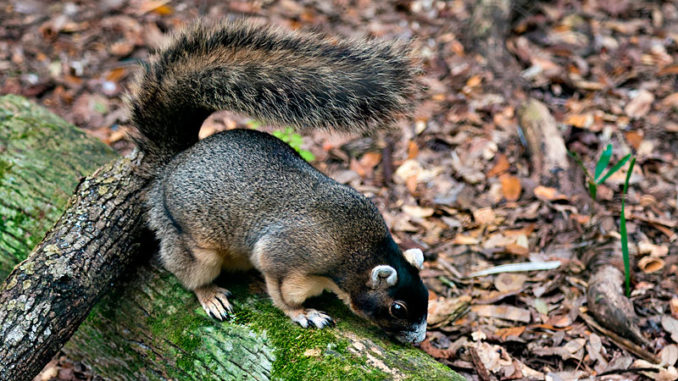
The fox squirrel (Sciurus niger), is the largest species of North American tree squirrels. Throughout the American south, fox squirrels live in relative harmony with other squirrel species like the gray and red squirrel, but they are physically quite different.
Fox squirrels are considerably larger than those other squirrels. And while they sometimes have the same color patterns as the smaller squirrels, fox squirrels can vary widely in color. They have the most varying color patterns of any mammal native to North America.
Even fox squirrels born in the same litter can be vastly different than their siblings. Some are pure white, others pure black — except for having white noses and ears. Others are a combination of gray, red, silver, yellow and brown.
Gray and red squirrels are often seen in pairs or groups of three or four, but it’s rare to see a fox squirrel that isn’t alone. Somewhat anti-social except during breeding season, they rarely mingle or fight with other squirrels. They don’t seem to mind when they’re approached by other squirrels. However, they tend to carry on their way alone after a short visit.
They eat a wide variety of foods including acorns, pecans, peanuts, corn, wheat, bulbs, roots, pine seeds, insects, bird eggs, berries and fruit. They bury a good deal of food in large caches — mainly acorns and other nuts, all still in the shell where they’ll keep fresh for extended time periods.
They like being grounded
For a tree dwelling animal, fox squirrels spend a surprising amount of time on the ground and are often observed hundreds of yards away from the nearest timber during their daily routines. They do prefer to nest in trees, building their nests quite a bit higher than other squirrels. Some nest in the hollowed out cavities of trees, while others build nests out of leaves, twigs or pine straw in the crooks of mature trees.
Unlike other squirrels, fox squirrels avoid thick wooded areas with lots of underbrush. They prefer mature pine trees, or a mixture of hardwoods and pine trees with lots of open space between them.
They are highly coveted by hunters, and are known as the trophy of all small game animals. Due partly to their solitary nature, they are much harder to hunt than gray or red squirrels. Those specifically targeting fox squirrels can sometimes go for days without spotting a fox squirrel, all the while feeling covered up with gray squirrels.
In the wild, fox squirrels generally live between 8 and 12 years, and those in captivity have lived as long as 18 years. Their mating season runs from mid-December through early January. This is often called “the other rut” by hunters, because it generally happens slightly later than the whitetail deer rut. Fox squirrels have a second mating season each year, mostly in June or early July.
The post “Species spotlight: Fox squirrel” first appeared on MS-Sportsman.com.